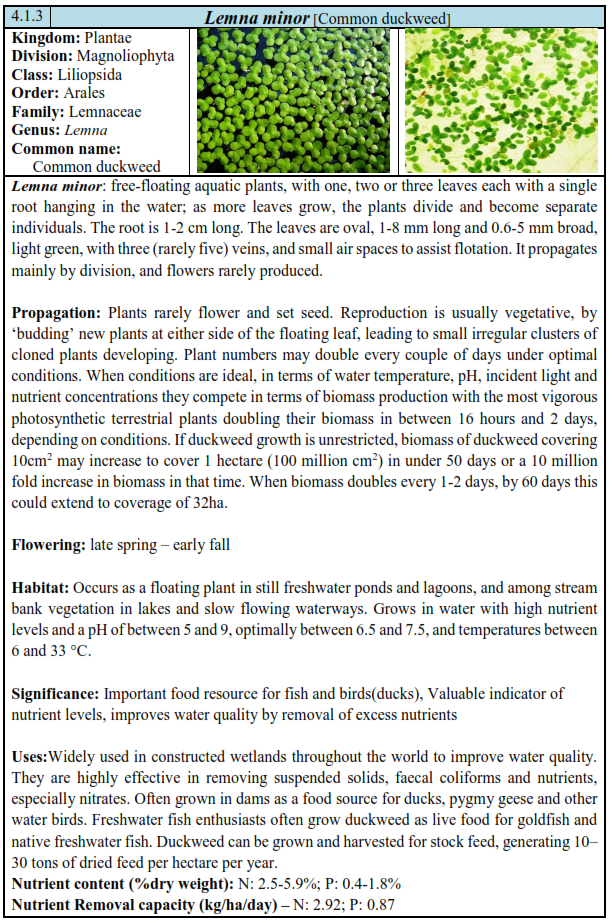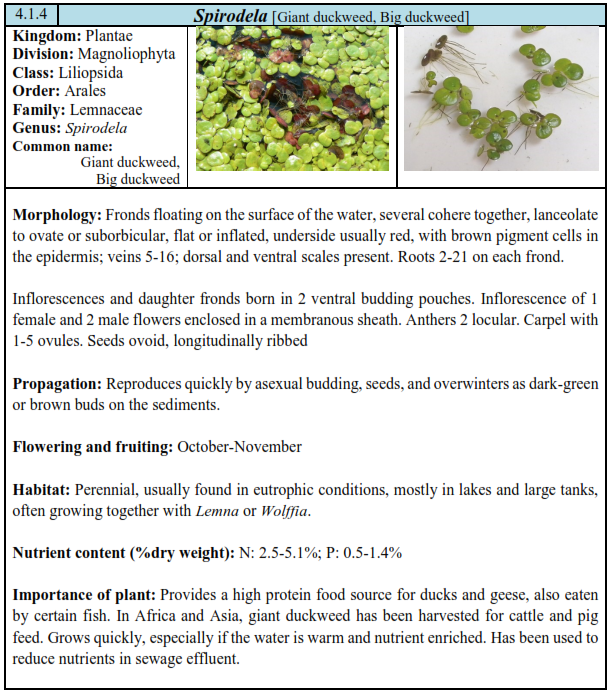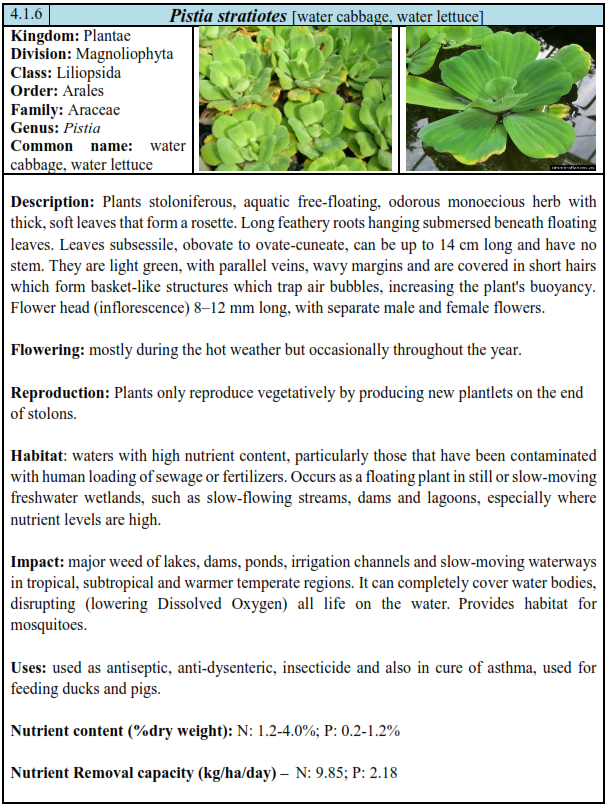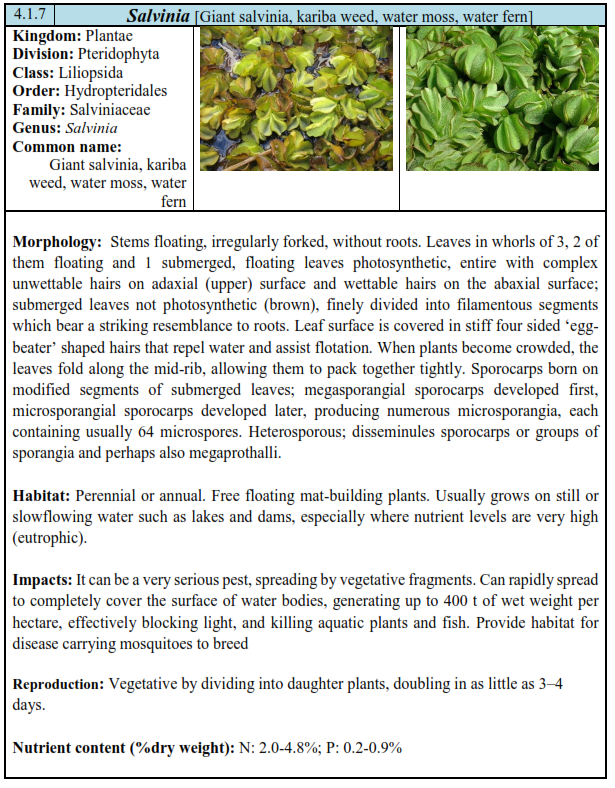|
|
ENVIS Technical Report 124, October 2017 |
CONSTRUCTED WETLANDS FOR TERTIARY TREATMENT OF WASTEWATER |
|
|
FREE FLOATING - AQUATIC PLANTS
Aquatic macrophytes are the vascular plants that are normally found growing in wetlands, either in or on the water, or where soils are flooded or saturated long enough for anaerobic conditions to develop in the root zone (Cowardin et.al 1979). The aquatic macrophytes occur mainly in the shallow region of lakes ponds, pools, marshes streams and rivers etc. Macrophytes are of considerable ecological and economic importance as they help in the uptake of nutrients and hence help in maintaining the chemical integrity of the respective ecosystem. They contribute significantly to the productivity of water bodies; mobilize mineral elements from the bottom sediments and provide shelter to aquatic macro invertebrates and fishes. They also respond to changes in water quality and have been used as indicators of pollution and are known as ‘bio-indicators’. When there is enough room for colonization and abundant availability of nutrients, macrophytes show a high growth rate. They assimilate nutrients directly into their tissues. Due to these they were used to solve eutrophic problems of freshwater bodies and to remove pollutants. Aquatic macrophytes belong to the following 3 categories on the basis of their habit:
- Submerged macrophytes: Largely or completely submerged plants, the roots may or may not be present (Ceratophyllum, Hydrilla, vallisneria etc);
- Emergent macrophytes: Plants not submerged in water, further subdivided into two (a) erect leaved emergent plants: rooted plants with principle photosynthetic surfaces projecting above the water (Typha, Scirpus etc) (b) floating leaved emergent plants: rooted plants with floating leaves (Nymphaea, Nelumbos etc);
- Floating macrophytes: Entire plant will be floating on the water surface (Eichhornia, Lemna, Pista etc); Floating attached macrophytes.
Macrophytes as indicator species: Wetland plants (Macrophytes) are the base of the food chain. Through photosynthesis, they link the inorganic environment with biotic one. Wetland plants have major effects in terms of physical (temperature, light penetration, soil characteristics) and Chemical environment of wetlands (dissolved oxygen, nutrient availability) and provide the basis of support for all wetland biota. They are drivers of ecosystem productivity and biogeochemical cycles, in part because they occupy a critical interface between sediments and overlying water column. Wetland plants grow in a variety of climates from the tropics to Polar Regions. Wherever the water table is high enough or the standing water is shallow enough, to support them.
Macrophytes, the aquatic macroscopic plants confine themselves to the shallow euphotic zone of the water bodies. In the littoral zone macrophytes are the chief exploiters of the plant nutrients from the sediments which otherwise are lost temporarily from the water. The nutrients so logged in the body material are released only after death, decay and subsequent mineralization thus, their role in nutrient dynamics and primary productivity of shallow systems. Therefore seasonal growth rate patterns and population dynamics of macrophytes are very important. When there is enough room for colonization and abundant availability of nutrients, macrophytes show a high growth rate. They assimilate nutrients directly into their tissues. Due to these, they were used to solve eutrophic problems of freshwater bodies and to remove pollutants.
Growth of vegetation in surface water is dependent on various factors such as the chemical and physical nature of the water; the nature of the bottoms, whether muddy or silt-laden; the climatic environment including meteorological conditions of a locality; edaphic and geological nature of the substratum and on the biological nature of the water. Biological nature is set up by the existence of plant and animal population in an expanse of water. Plant and animal organisms by their vital actions and reactions maintain a state of transparency and purity of water (Biswas K and Calder C.C, 1954).
Sampling: The sampling of macrophyte depends on type of habit, type of vegetation, variation and distribution of the vegetation and aim of the study. It is essential to first survey the area and decide about the suitable sampling methods. Quadrat method of sampling is followed (50 cmX50cm or 1mX1m for emergent).
Identification of Macrophytes: collected samples be identified using morphological and phonological features using published flora.
Vegetation mapping: This is done 1)to calculate total macrophytic biomass of different species in a water body 2)to understand the distribution pattern of vegetation 3) to monitor the changes caused by a pollutant on these patterns at various times.
Treatment of samples: Immediately after collection wash the plants to remove adhered soil, epiphytes etc. Drain out the excess water after washing. Take the fresh weight of sample. Transport the samples to the lab in polythene bags.
Biomass estimation: After determining fresh weight of the samples, keep the samples in hot air oven at 105°Cfor 24 hrs for the determination of dry weight. Biomass is usually estimated as dry matter per unit area.








|
Dr. T.V. Ramachandra
Centre for Sustainable Technologies, Centre for infrastructure, Sustainable Transportation and Urban Planning (CiSTUP), Energy & Wetlands Research Group, Centre for Ecological Sciences, Indian Institute of Science, Bangalore – 560 012, INDIA.
E-mail : tvr@iisc.ac.in
Tel: 91-080-22933099/23600985,
Fax: 91-080-23601428/23600085
Web: http://ces.iisc.ac.in/energy
Sudarshan P. Bhat Energy & Wetlands Research Group, Centre for Ecological Sciences, Indian Institute of Science, Bangalore – 560 012, INDIA.
E-mail: sudarshanb@iisc.ac.in
Vinay S.Energy & Wetlands Research Group, Centre for Ecological Sciences, Indian Institute of Science, Bangalore – 560 012, INDIA.
E-mail: svinay@iisc.ac.in
Citation:Ramachandra T V, Sudarshan Bhat and Vinay S, 2017. Constructed Wetlands for Tertiary treatment of Wastewater, ENVIS Technical Report 124, Energy & Wetlands Research Group, CES, Indian Institute of Science, Bangalore 560012
| Contact Address : |
| |
Dr. T.V. Ramachandra
Energy & Wetlands Research Group,
Centre for Ecological Sciences, TE 15, New Biology Building, Third Floor, E Wing, [Near D Gate], Indian Institute of Science, Bangalore – 560 012, INDIA.
Tel : 91-80-22933099 / 22933503-extn 107
Fax : 91-80-23601428 / 23600085 / 23600683 [CES-TVR]
E-mail : tvr@iisc.ac.in, energy@ces.iisc.ac.in,
Web : http://wgbis.ces.iisc.ac.in/energy |
|







